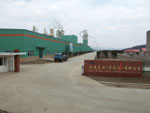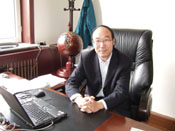From Russia with wood
17 August 2009Suifenhe is a far-flung outpost of the People’s Republic, hanging onto its Chinese nationality by a thread as it sits on the very border with Russia in the northeast province of Heilongjiang.
Even in the very last days of April, the evening temperature is hovering around zero centigrade and the trees and shrubs are still bare sticks in a parched, wintry landscape.
The first shoots of spring are not expected for another month and yesterday’s now dirty snowfall still lies beside the roads.
The drive from the nearest airport, Mudanjiang, a small facility with only a few flights a day, on a Sunday night is long and uncomfortable on a cracked and broken twisting concrete single carriageway road that winds through the mountains. It is 160km but feels like a lot more.
Three lives are lost tonight – wasted in a head-on collision just ahead of us an hour out of Mudanjiang as the frustration of the relatively narrow road and slow-moving vehicles presumably became too much for somebody.
On the return journey the next day, a motorcyclist lies dead in the road in a pool of blood as the traffic drives around him. I am told it is much worse in the winter months.
The journey is completed in the dark, but even so, the approach to Suifenhe gives a very strong clue as to why Dare chose this rather inhospitable-looking area for its latest mill.
I have never seen so much wood in China, ever. And I have travelled
extensively in this country of so many different scenes.
It is stacked beside the road, it is loaded on lorries in log form, it is piled high at sawmills beside the road, it is stacked in small sizes outside the poor dark brick cottages of the local people. I later discover that there are 460 wood processing plants here, of all sizes.
Clearly wood is Suifenhe’s gold and it mostly comes from close neighbour Russia; the border between the People’s Republic of China and the state of Russia is about 100m from the Holiday Inn in Suifenhe.
One is used to seeing many bilingual signs in English and Chinese everywhere in China, but here they are in Russian and Chinese most of the way from Mudanjiang.
The drive to the factory from the hotel the next morning is mainly over compacted mud, past more sawmills and other wood processing operations, until we arrive at the Dare Group’s latest continuous MDF/HDF production line, rearing up out of the surrounding countryside with its high cyclone towers.
Dare Global group has a total of eight panel production lines – four of them Siempelkamp ContiRoll continuous lines each with annual capacities of 200,000m3.
These Siempelkamp lines are located at: Danyang, Jiangsu Province (the first such line to be built by the group); Fuzhou, Jiangxi; Maoming, Guangdong; and here at Suifenhe in Heilongjiang Province.
There is also a Dieffenbacher CPS continuous line for thin HDF at Deqing in Guangdong Province. That has a capacity of 150,000m3/year and started production in 2008.
Dare also has two older multi-opening lines producing MDF – one in Jiangsu Province, the other in Anhui Province. Each can produce around 100,000m3 a year and each was supplied by Shanghai Wood Based Panel Machinery Co Ltd.
Dare Global also made one foray into particleboard, building another Siempelkamp ContiRoll line at Sanming, Fujian Province. This line has an annual capacity of 450,000m3.
The company’s activities in the wood products industry are broadly divided into four product groups: Panels; flooring; solid wood products; and furniture.
The flooring division produces three different types of product: Solid wood; multi-layer wood; and laminate flooring. The main flooring production activity is centred on Danyang in Jiangsu Province.
The furniture factories make both solid wood and MDF furniture, with three factories – in Danyang and in Fujian Province.
Dare also has a door making factory and another small unit making architectural wood trim.
The group uses three brand names: Dare Wood Group; Power Dekor (for laminate flooring); and Kangsu (for solid wood flooring).
The wood group in total has a turnover of seven billion yuan (US$1.03bn). The group also has other diverse interests outside wood, giving it a total turnover of more than RMB10bn.
“That first ContiRoll line in Danyang started production in 2003 and now, six years later, we have built this plant in northeast China,said Suifenhe’s general manager Shen Dan, whom I first met when Danyang was under construction. “Danyang was the first continuous line for Dare and this is the first time that such a large company has built a panel manufacturing plant in this part of China.
“Danyang took around 14 or 15 months from start of construction to the first board. Suifenhe took 14 months and 20 days,said Mr Shen.
The company is particularly proud of this achievement because the conditions here bear no comparison with Danyang much farther south. To give some idea, I left Beijing in temperatures in the mid to high 20s centigrade on Sunday afternoon to disembark from the plane in zero degrees two hours later.
In the Suifenhe winter, temperatures regularly fall into large minus figures and when the first board was produced in December 2008, it was minus 28oC. Perhaps Dare was lucky – some years it falls to minus 40oC.
Although the heart of the two lines is similar – Siempelkamp ContiRolls – other elements are different, as Mr Shen pointed out.
For instance, firstly, Danyang purchased wood preparation and refining equipment from Andritz and the energy plant from Vyncke of Belgium.
Suifenhe has chip dry cleaning and refining and dryer from Metso, while the energy plant was supplied by Chinese company Changzhou Union.
However, machinery sourcing was not the only difference between the two plants – the technology employed was also different.
In Danyang, chips are washed before refining but for Suifenhe, it was decided that dry cleaning would be cheaper and better; it is the first such plant in China. Anyway, chip washing in the winter is out of the question here.
Also the dryer is two-stage as opposed to the single-stage dryer employed in Danyang.
The Suifenhe line is also designed to produce both thin board and low-density board from its ContiRoll.
“The target of our Suifenhe mill at the moment is environmentally-friendly production of medium and high density board for the furniture industry,said Mr Shen. “Danyang and the other Dare fibreboard lines are mainly producing board for flooring.
“There is a fundamental difference between Chinese MDF and foreign-made board for furniture production and that is the density. In China, people prefer 750kg/m3 or more but, according to my experience, foreigners prefer 650kg/m3 or less,explained the general manager.
“As far as I am concerned, China will also realise the need for lower density board for furniture in time and so Dare Group is trying to use this line to produce lower density board for the first time in China. I think this concept, which now belongs to Dare, will in the future influence the whole Chinese wood products industry.”
Mr Shen went on to point out that most furniture board in China is produced on multi-opening lines and he feels that the quality and cost is a big problem for these lines.
“We urgently need to upgrade the quality and technology of furniture board manufacture in China,he said.
“We feel that our group is competitive because we use the ContiRoll and of course we have some other ideas, too. A Siempelkamp four-feet-wide ContiRoll with an annual capacity of 100,000m3 I think would be the most economical way to produce furniture board. That is just my idea, though.”
The Suifenhe ContiRoll does not however follow this principle. It is 8ft 6in wide and 37.1m long.
“This line is not only for furniture board and the Dare group tends to invest in big lines,explained Mr Shen.
“This line is designed for an annual capacity of 200,000m3 but I am sure that in future, if we build another line, it will be more like 150,000m3 or less due to pressure on wood resources. Personally, I think this is the way China will go in the future.”
Mr Shen went on to explain that there is another fundamental difference between the Suifenhe line and Danyang and that concerns the resources.
“Most of the wood we purchase here comes from Russian wood processors. In terms of quality I think China has very good wood resources, but in the south it is mostly faster-grown wood and I think the main difference between Chinese and foreign boards for furniture production is in the wood raw material and we are able to change that situation.
“Every year, this city imports around seven million cubic metres of logs and it processes three to four million cubic metres of raw wood. This is the most important reason for Dare being here – both the quantity and the quality of the wood.”
I raised with Mr Shen the question of Russian export taxes on logs, delayed earlier this year (WBPI Feb/March, p5).
“We have considered this [threat to supplies] but we expect cost in the coming years to be stable – far east Russia relies heavily on log exports for its living. I cannot deny that in coming years there may be limitations on wood supply from Russia as its economy grows, but there is also a local supply of good wood around Suifenhe itself.”
Dare only has a relatively small back-up chipper in Suifenhe and relies mainly on prepared chips from the surrounding wood processing industries.
Mr Shen’s fifth and final point concerning the significant differences between the Danyang operation and here concerns the market.
“We can take advantage of the area of this city and can export to Russia, Japan and South Korea, although our largest market is northern China – Dalian, Harbin and Shenyang.
Actually there is a sixth difference – the climate!continued Mr Shen, smiling. “From December to April it is normally below 15oC at least and this does cause us a lot of difficulties – especially as the management is from the south!”
Mr Shen admitted that the Chinese market is currently out of balance, with supply exceeding demand.
“Because of this, China has to reconsider the whole market,he said. “Maybe there needs to be some integration and the closing of plants with capacities below 30,000m3/year.
“But the situation in China is very complicated. It is a huge country and different areas have different situations. We expected more integration in 2005/6 but it didn’t happen. We still believe the Chinese panel industry has a bright future because, in the end, the market decides everything.”

